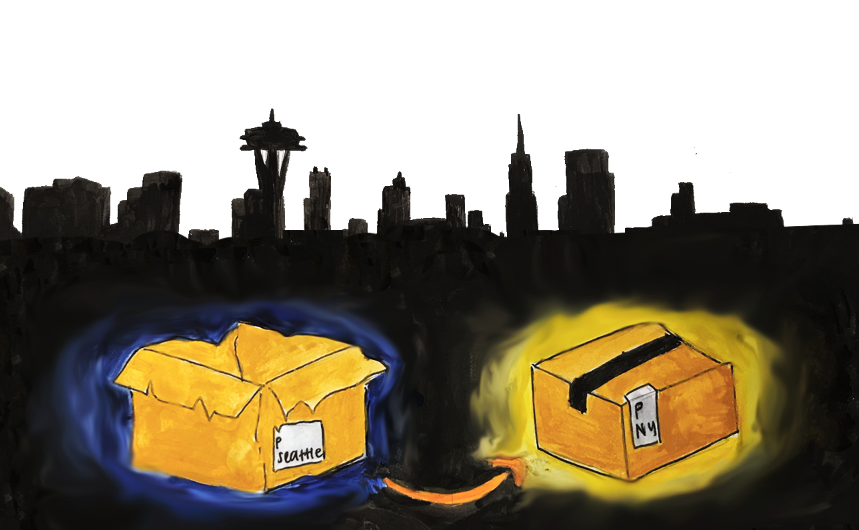Unpacking Amazon’s controversies
February 1, 2019
After Amazon unboxed its newest project, Amazon Headquarters 2.0 (HQ2), protesters filled the streets of New York City to voice their dissent for this decision. Criticism over the headquarters’ locations and working conditions have fueled public disapproval of Amazon. The retail giant’s actions, though legal, are morally wrong and require serious revision.
In November 2018, Amazon announced its plan to build a second headquarters split between two campuses: one in Long Island, New York, and another in Crystal City, Virginia. The company is set to receive $3 million in state and city incentives on top of the bid money for its new campuses, a reward for the revenue Amazon could possibly generate for the cities. Bidding prices started from $5 billion, but in an effort to beat out other rival states, many states bid more than required. Many expressed disapproval over the billions wasted in bidding that could have been used to benefit city residents.
“It is interesting to see these competitions between states to incentivize companies to relocate because you need to look at whether it’s a good deal for the states,” said economics and government teacher Jeffrey Bale. “States have provided housing for employees and huge tax breaks for Amazon. If you look back on it, the taxpayers’ dollars aren’t being repaid in the long run.”
Amazon has received immense backlash for HQ2; residents of each city were not notified prior to Amazon’s decision to house its headquarters in these two cities because no public hearings or votes on the project were held. While withholding company decisions are not illegal, the inhabitants of Long Island and Crystal City had no say in a decision that could drastically change their everyday lives. While Amazon’s presence can certainly boost the cities’ economies, it can also have other consequences: sky-high housing prices which may lead to an increase in homelessness. New job openings mean more demand for housing, which further drives up housing prices of already expensive areas, including New York. The worsening traffic, rising housing prices and homelessness crisis in Seattle, Amazon’s mother city, are examples of the possible repercussions of HQ2.
“If you’re putting a headquarters in a major metropolitan area, it’ll cause greater problems,” said AP U.S. History and World History teacher Steven Roy. “There are plenty of non-major metropolitan areas that have good infrastructure that are good choices. For example, there is Detroit, which is economically depressed and could use the economic boost.”
Amazon’s announcement of HQ2 comes a few months after a controversy concerning its neglect of blue-collar workers, the backbone of the company’s success. At the time, many delivery workers, packers and forklift drivers lived paycheck to paycheck on a $13.50 per hour wage. New Food Economy found that in 2017, nearly one in three Amazon employees in Arizona were on food stamps or living with someone who was, indicating that many workers were below the poverty line.
Amazon warehouse workers have a package quota to fill, and many strain themselves in order to achieve these quotas. The strenuous labor involved, in addition to the long work hours and limited breaks have resulted in worker injuries, miscarriages and even deaths. According to Vice, 600 ambulance calls have been placed for Amazon employees due to injuries in Amazon UK warehouses from 2015 to 2018, an amount that far surpasses that of local shipping businesses.
“My job is not just like a normal ice cream scooping job. You have to make ice cream from start to finish, and you stand there for hours and hours with maybe a 10-minute break in between,” said senior Aditi Raja, a part-time worker at Creamistry. “I can’t imagine how much more strenuous it must be for Amazon workers. I would be fed up by the end, and the thing is now, I could quit my job, and I could be fine, but the Amazon workers can’t do that.”
In interviews and news stories, vocal workers have spoken out about the abuse they endured from having been treated solely as producers. Tasha Murrell, an ex-worker at an Amazon warehouse in Memphis, miscarried due to continuous, hard labor and long hours due to neglect. When asked if she could take time off, her supervisor coldly told her to get an abortion and said that she would not authorize Murrell’s absence. Later that day, Murrell miscarried.
Worker dissatisfaction eventually led to protests, in which workers demanded for higher wages and better treatment. For all the work they do, they deserve fair treatment. After much effort to quell protests to no avail, Amazon finally relented and increased wages of workers, though not without first cutting performance bonuses that could result in up to a loss of $300 per month.
“Total compensation includes all benefits and any bonuses that might occur,” Bale said. “Changing one element but reducing another doesn’t necessarily mean it’s better.”
In recent months, efforts have been made to raise the wages of Amazon workers to $15.25 per hour. However, the money is not enough. Workers need safer working environments, as well as more frequent breaks and maternity leave. Amazon makes millions, and without the support of their blue collar workers, Amazon would not be the big corporation it is today.
Amazon’s move to New York and Virginia may seem to be a done deal, but legislative changes ameliorating current worker conditions can prevent crises. Politicians and advocates such as Lisa Herbold and Terekk, sa Mosqueda of the Seattle City Council are pushing for a law that will hold Amazon accountable for the consequences of creating HQ2, and have even gone as far as traveling to New York to deliver their warnings. Among some of the discussed proposals are helping out with keeping the homelessness rates down ‘’and addressing the needs of Amazon’s blue collar workers.
Fellow giant Microsoft, also with a headquarters in Seattle, has set an example for corporations and their relationships with their home cities, as it is currently investing $500 million into Seattle to help with low income housing. Likewise, Amazon should follow in the footsteps of Microsoft and contribute to the communities they are building in.
It is now up to Amazon to heed the people’s demands and take action before its problems escalate.




























































